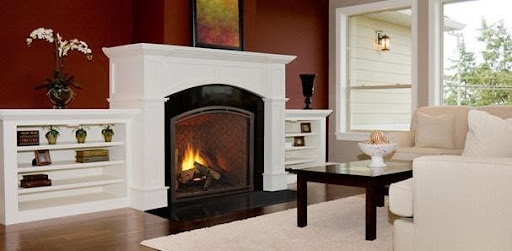Gas-burning fireplaces are gaining popularity. With the flip of a switch, you may enjoy a comfortable, warm fire without the work and messiness of actual logs, or the smoke and pollutants. Gas fireplaces have an efficiency rating of up to 90%, which means they emit nearly no pollutants. Beneficial to you, your house, and the environment.
Gas fireplaces are now made to look just like a real wood-burning fireplace, and many people can’t tell the difference. They feature the typical bright red embers and orange flames of a wood fire. There isn’t the nostalgic crackle and snap of a genuine fire, but what you don’t get is highly clean, adaptable warmth, and cost-effective convenience. There are also several fireplace designs and installation choices to choose from. You may select the design that best complements your house, and you can put a fireplace in more rooms than ever before.
Built-ins
Built-ins are similar to inserts in that they are built in a box within a box, but they do not require an existing fireplace. They may be put in nearly any location. They cycle the air and exhaust via an outside wall opening in vented units. Vent-free units circulate and exhaust air into the room. The vented units, like the inserts, have a fixed glass panel, whilst the vent-free units have a fixed glass panel or metal screen. Built-ins, like inserts, are dependable heat providers.
Inserts
Inserts are a log-and-burner set that goes within a metal box, which is then fitted into an existing fireplace. The insert heats the air in the space between the two boxes. It then radiates the warmed air emitted by the fireplace. Inserts are extremely dependable heat generators. Drilling holes are required for electrical or gas lines, and the insert can be vented or vent-free. In the case of vented, there is normally a fixed glass panel in front of the flames, and in the case of vent-free, there is either a fixed glass panel or a metal screen.
Sets Of Logs
Log sets are the least expensive alternative and are typically built for aesthetics rather than warmth. Ceramic logs are placed on purpose in your current fireplace with a gas burner. Drilling access holes for electrical or gas lines is all that is required for installation. Some units are ventless, while others are vented. To prevent CO poisoning in vented setups, the fireplace damper must be kept open at all times. This approach might be disadvantageous since much of the heat is lost through the flue.
Design Of A Fireplace
All three of these options provide design alternatives. One such option is a substitute for the logs themselves. are now opting for these options to get a fresh look. Tempered glass chips, ceramic coal lumps, and ceramic stones are some of the available log replacements. Each of these options depicts a different period or provides a whole distinct vibe to the location.
Vent-Free vs. Vented Fireplaces
While gas fireplaces do not emit scents or smoke, their flames do emit pollutants such as carbon monoxide, nitrogen oxides, and sulfur oxides. These pollutants are expelled by vented fireplaces. Vent-free fireplaces, on the other hand, blow them into your home. When deciding whether to install a vented or vent-free set, like with so many other things. Each option has benefits and drawbacks. Overall, vented systems are less efficient than vent-free systems. However, vented systems are the most secure inventions. Vent-free systems are approximately 100 percent efficient and may be installed almost anywhere. even on a wall, such as a television and one of our knowledgeable experts would gladly go over the vented vs. vent-free choices with you.
Today, there are several alternatives for gas fireplaces. These fireplaces are not always installed for their ability to generate heat. Many are just decorative. Whether you want to convert your existing wood-burning fireplace or build a new outdoor gas fireplace on your patio, we have you covered.

